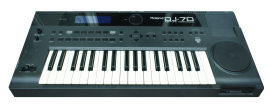


Trend price : 150€
A totally forgotten sampler produced the nineties by Roland Italy, launched as the "DJ" version of famous and professional module S-770/S-750.
Company: Roland
Model: DJ-70
Class: Sampler keyboard
Keyboard: 61 dynamic keys
Display: 64 x 240 pixels
Dates: 1992
Price: 150€
Resolution: 16 bits
Polyphony: 24 voices
Algorithms: 6 modes
Memory: from 2 to 4 mb
Filter: LPF / HPF / BPF
LFO: 1 / partial
Envelope: 2 EGs
Sequencer: 8 tracks
Memory: 1 up to 4 mb
Storage: FD HD 1,44 mb
CPU: 80C196
DAC: PCM54HP
Demo: 1
Video: 1
Review 1
DOWNLOAD: user manual -
Service Manual
Main panel features a 64 x 240 pixels backlit display,42 push buttons, a data encoder, 2 knobs, a pitchbender joystick and a special scratchpad.
Terminal connectors:
-
main signal out
- stereo input with gain trimmer
- Midi interface
- display contrast trimmer
- pedalswitch sustain input
- Cue headphones preview with individual gain.
Voice
24 voices polyphony.
The stereo sampling engine works at 16 bits resolution with 2 fixed recording frequencies: 22,05 and 44,1 kHz.
SAMPLE IMPORT it is possible to Midi sample dump or load import S770, S750, W30, S550, S50 using a dedicated tool into utility section.
Sound Structure a single sample can be modified with various edit functions:
- loop (forward, backward, ping pong)
- pitch tuning
- smooth (crossfade)
- gain (normalize)
- cut, paste, truncate, trim, split
- resample to: 44,1 / 30 / 24 / 22,05 / 15
kHz
- time stretch from 25 to 400% ratio (calculation time can be really long).
Edit
The hierarchy is basically the following structure: samples->partial->patch->performance. A partial is composed by up to 4 samples (each with own level, tuning, pan) then partial are assigned to keyboard zone (from 1 to 88) in a patch. Finally up to 31 patches can be assigned to a performance with an assigned channel.
Resampler
2 samples can be combined in 6 algorithms or structures same found on synthesizer module JD-990. These are pre-fixed audio patches that connect 2 samples into variable setups mixed with 3 audio elements: amplifier (TVA), filter (TVF) and ringmodulation (R).
Filter
multimode resonant filter: lowpass, highpass, bandpass + keyfollow option.
LFO
each partial features a single syncable delayed modulator (shapes: sine triangle, saw up, saw down, square, random, bend up, bend down). Modulation destinations are:
- LFO to amplitude
- LFO to filter cutoff
- LFO to sample pitch.
Envelope
- EG1 TVF: 4 segments + 4 times
- EG2 TVA:
4 segments + 4 times.
EG TVA
features some typical envelope presets to go e.g. piano, organ, brass, percussion, strings
Sequencer
the RPS sequencer (Realtime Phrase Sequencer) features 8 tracks.
The RPS is like a litte notepad for idea on the fly, since it does not contains edit functions like sync, quantisizer nor even a metronome... what a waste.
Memory
- 512 samples
- 255 partials
- 64 performance
-
sampling 2 Mbytes factory, expandable to 4 Mb using standard 30 pins SIMMS (1 mega each).
STORAGE floppy disk drive format 3.5 DD/HD 1440 /720 Kb capacity with auto-boot function.
Review
OK: -cheap- filter-realtime algorithms- a glitch machine
NOT : - interface- storage
/ memory-sequencer -slow CPU -timestretch
"A kind of S770 enclosed into a cheesy scratching- 90-commercial-DJ case. Algoritms allows unlimited texture and lofi glitched sounds. Many people get fooled by the "easy" DJ approach, but the this sampler is a quite complex machine with a LOT of advanced synthesis functions, sadly hidden in a not-so-obvious edit interface.

Text , review, special demos copyright polynominal.com / Eric Pochesci